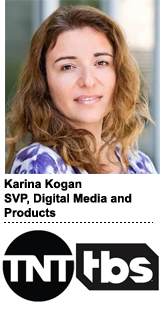
TBS and TNT try to be “brands that live outside of television,” said Karina Kogan, SVP of digital media and products for the two networks.
Beyond its owned-and-operated networks, sites and apps, Facebook, YouTube and Snapchat are the networks’ workhorses for driving engagement with viewers – and acquiring new ones.
“We start with who’s watching the show and why are they going to watch it, and based on that, we make the decisions on what content we’ll create,” Kogan said.
Often, Turner leans on social platforms as an audience development tool to promote new series, such as TNT’s psychological thriller “The Alienist” and comedian Conan O’Brien’s animated Snapchat series, “Team Coco’s Comedy Club.”
Kogan spoke with AdExchanger about how TBS and TNT balance their off-platform push with Turner’s owned-and-operated activations.
AdExchanger: First, what is TBS’ and TNT’s approach to digital media?
KARINA KOGAN: I’m focused on total audience development and social monetization. How do we use these platforms holistically to enhance our overall business goals and drive audience engagement on those platforms, or use them to drive audiences to our O&O? We look at the role short-form content plays in those ecosystems and how it benefits our businesses holistically.
My team is heavily involved in figuring out what’s most compelling about a program and how would that play out in social. Would you engage with this content on its own as a standalone because it has a beginning, middle and end? That content can span from ancillary series to Facebook Live … or producing segments with influencers.
Turner creates a lot of bespoke content for promotional purposes, but who’s responsible for it?
The marketing team under our CMO is broken into four groups: digital, brand marketing, brand strategy and brand creative.
The brand creative team is most engaged with the various makers of our programs, like the developers and producers. When we go to market with a show, we think about our content plan, and that includes everything from trailers and clips to last week’s [spots].
The first body of work is designed to get somebody to watch and tune in. The second body of work is designed for continuity: to draw an audience to a show, build awareness, engagement and interaction once you have a fan base.
How would you rate Facebook as a video platform partner compared to YouTube?
I still think companies like Facebook are very much platform companies. They’re not content companies. They’re just not wired that way. That said, Facebook continues to be one of the best, if not the best, marketing platform out there. It’s super data-rich and so big and turnkey from an advertiser’s perspective.
But it’s not yet really a great content platform, [considering] most people don’t watch video with sound on and past three seconds. So I think Watch has a long way to go.
The big difference is that YouTube from the get-go was a video product. When you saw a YouTube video player embedded somewhere, you knew to click to watch a video. Facebook is not a video company. Facebook is a news feed company, and videos may be one thing in your feed, but behaviorally, it is not a place you come to consume video.
In general, it’s sometimes funny to compare the two because they’re not the same thing, which is why, on average, we tend to see better engagement with YouTube.
What about from an ads perspective?
As far as the monetization, YouTube is a much more sophisticated product for any brand to make money – they built a whole economy on top of YouTube for people to make money from content.
Facebook has a long way to go to get there, and even creators who make content for Facebook find it confusing still. It’s like, how much money can I make? What are the metrics advertisers are looking for?
How does TBS and TNT decide what content to push to social and what to prioritize on O&O?
Every piece of programming that the network produces goes through our O&O: linear television, VOD and our owned-and-operated platforms. Then there’s this entire ecosystem of content we produce that’s essentially [series and program] marketing, but in today’s age on social, you can’t be a transactional marketer. I always tell my team, stop marketing to our audience and start programming for our audience.
We live in a world today where content is marketing, so when you’re looking for engagement and time spent – these metrics that are the currency for success in marketing – you’re really thinking about the same metrics to measure success in driving viewership and content.
Interview condensed
This post was syndicated from Ad Exchanger.

More Stories
Lush’s beauty revolution with Sling & Stone
In Bridgerton and Flonase Collaboration, Both Love and Allergies Are in Bloom
SME-focused PrettyGood launches in Australasia